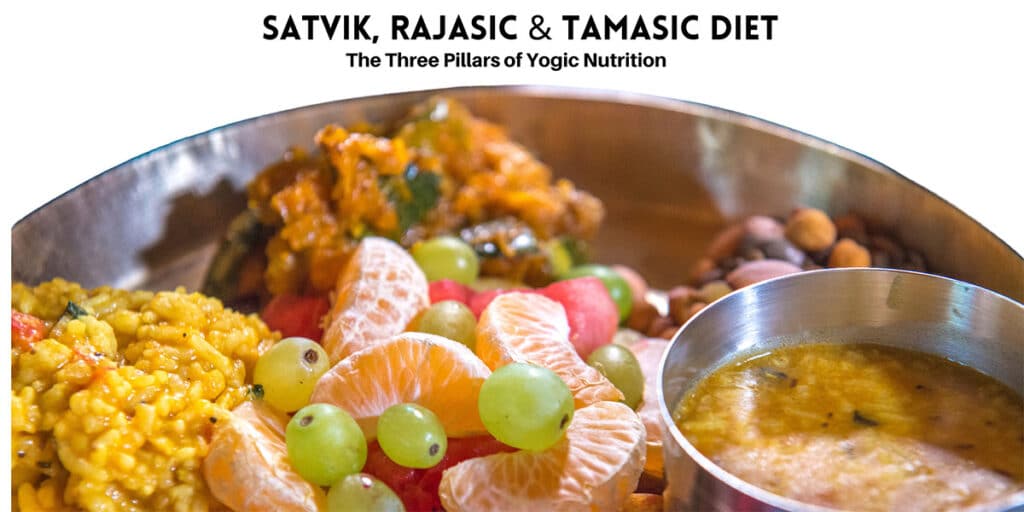Understanding Diet According to Yoga: The Satvik, Rajasic, and Tamasic Approach
by Hardik Mehta

In yogic philosophy, food is considered more than just fuel for the body; it is a powerful medium that influences our mind, emotions and overall well-being. The ancient wisdom of yoga categorizes food into three distinct types: Satvik, Rajasic, and Tamasic. These classifications not only guide our physical health but also impact our mental clarity, emotional stability and spiritual growth.
In this blog, we will explore the concept of diet as per yoga and understand the characteristics, benefits and potential downsides of each dietary category.
The Yogic Perspective on Food
In the yogic tradition, food is seen as energy, or prana—the life force. The food we eat shapes our body and mind, thus influencing our emotions and spiritual evolution. When viewed from a yogic perspective, the ideal diet promotes harmony between body, mind, and spirit and enables the individual to attain higher consciousness.
The three categories of food—Satvik, Rajasic, and Tamasic—are derived from the three gunas or qualities of nature: sattva (purity, harmony), rajas (activity, passion), and tamas (inertia, darkness). These gunas are present in every aspect of existence, including the food we eat. Let’s explore each dietary category in detail.
- The Satvik Diet: A Path to Purity and Harmony
Satvik food is the ideal diet recommended for those following the path of yoga. It promotes purity of both body and mind and leads to clarity, calmness, and heightened spiritual awareness.
Characteristics of Satvik Food
- Pure and Fresh: Satvik foods are natural, unprocessed, and freshly prepared. These foods are free from toxins and are easily digestible.
- Light and Balanced: This diet avoids excess, meaning that foods are light yet nourishing. It avoids overly spicy, salty, or oily foods that may create imbalance in the body.
- Vegetarian: A Satvik diet is strictly vegetarian, consisting of fresh fruits, vegetables, whole grains, nuts, seeds, legumes and dairy products like milk and ghee.
- Rich in Prana: Since prana is essential for vitality and consciousness, Satvik foods are high in life energy. Freshly picked fruits, organic vegetables and sprouted grains are considered to have abundant prana.
Benefits of a Satvik Diet
- Mental Clarity and Calmness: Satvik food promotes calmness and mental clarity. It helps reduce stress, anxiety, and negative emotions, making the mind more receptive to meditation and spiritual practices.
- Physical Health: The emphasis on fresh, wholesome, and nutrient-dense foods enhances overall health and immunity.
- Spiritual Growth: Satvik food supports a peaceful state of mind, which is essential for spiritual development. It helps elevate consciousness and promotes qualities like compassion, humility and kindness.
Examples of Satvik Foods
- Fruits and vegetables (especially leafy greens)
- Whole grains like rice, quinoa, oats, and millet
- Nuts and seeds (almonds, flaxseeds, chia seeds)
- Dairy products such as fresh milk, yogurt, and ghee
- Herbal teas, fresh fruit juices, and pure water
- The Rajasic Diet: Fuel for Activity and Passion
Rajasic food is characterized by its stimulating nature, driving action, energy, and movement. People who lead an active, fast-paced lifestyle often gravitate toward Rajasic foods to maintain their energy levels and productivity.
Characteristics of Rajasic Food
- Stimulating and Energizing: Rajasic foods are often spicy, salty, and pungent. They stimulate the senses and increase the body’s metabolic rate.
- Exciting and Varied: This diet includes foods that are flavourful, heavily spiced, and rich in ingredients, which can create excitement and motivation but may overstimulate the mind.
- Moderately Processed: Unlike Satvik food, Rajasic food may include moderate amounts of processed or refined ingredients, such as refined sugars, caffeinated drinks, and rich spices.
- High in Calories: Rajasic foods are often higher in calories and are used to fuel physical activity and mental exertion.
Benefits of a Rajasic Diet
- Increased Energy: This diet enhances physical and mental energy, making it suitable for those engaged in active, high-performance tasks.
- Sharp Focus: Rajasic foods may help sharpen focus and alertness, making the mind more responsive and quicker.
- Drive and Ambition: The stimulating properties of Rajasic food fuel ambition, passion and competitiveness. This can be beneficial in achieving goals and driving success.
Potential Downsides of a Rajasic Diet
While Rajasic food enhances physical energy and mental sharpness, it can also overstimulate the mind, leading to restlessness, anxiety and irritability. Prolonged consumption of Rajasic food may disturb mental peace and make it difficult to cultivate calmness and stillness, which are essential for meditation and spiritual growth.
Examples of Rajasic Foods
- Spicy and salty foods
- Onions, garlic, and strong spices like chili, pepper and ginger
- Caffeinated drinks like coffee, tea and energy drinks
- Fried foods, processed snacks and sweets
- The Tamasic Diet: A State of Inertia and Lethargy
Tamasic food is associated with dullness, inertia, and heaviness. This type of food creates lethargy, fatigue, and mental confusion. It is generally considered the least conducive to health and well-being from a yogic perspective.
Characteristics of Tamasic Food
- Stale and Overly Processed: Tamasic foods include leftovers, stale, or overly processed items that have lost their natural vitality. These foods are low in prana and often high in preservatives and chemicals.
- Heavy and Greasy: Foods that are fried, greasy, or overly fatty fall into the Tamasic category. They tend to be heavy and difficult to digest.
- Overly Sweet or Oily: Foods that are excessively sugary, salty, or oily contribute to a Tamasic state by creating heaviness and sluggishness in the body.
- Toxic and Addictive: Tamasic foods may include alcohol, tobacco, and drugs, which dull the mind and senses. These substances create dependency and disturb mental equilibrium.
Effects of a Tamasic Diet
- Physical and Mental Dullness: Tamasic food decreases mental clarity, creativity, and vitality. It promotes lethargy and can lead to a lack of motivation or enthusiasm.
- Impaired Health: The lack of nutrients in Tamasic foods can weaken the immune system and increase the risk of illness.
- Emotional Imbalance: Prolonged consumption of Tamasic food can lead to feelings of depression, confusion, and emotional instability.
Examples of Tamasic Foods
- Stale or reheated food
- Processed and junk foods (fast food, packaged snacks)
- Meat, especially red meat
- Alcohol, tobacco, and recreational drugs
- Excessively sweet or oily foods
The Ideal Yogic Diet: Finding Balance
In the yogic tradition, a Satvik diet is considered the most suitable for achieving a balanced, peaceful, and harmonious state of being. However, depending on one’s lifestyle and personal needs, elements of a Rajasic diet may be included for energy and activity, particularly for those engaged in demanding physical or mental work.
Tamasic foods, on the other hand, are best avoided or consumed in minimal quantities, as they hinder both physical vitality and spiritual growth.
The concept of diet in yoga extends beyond the mere physical body to encompass mental, emotional and spiritual dimensions. A Satvik diet, rich in prana and purity, nurtures the mind and spirit, promoting clarity and peace. Rajasic food provides the necessary stimulation for action but must be balanced to avoid overstimulation. Tamasic food, while easy to indulge in, dulls the senses and hampers progress in all areas of life.
By understanding the Satvik, Rajasic and Tamasic qualities of food, one can make informed dietary choices that not only nourish the body but also support a higher state of consciousness and well-being.
About the Author

Hardik Mehta
Hardik is an E-RYT 500 & YACEP (Yoga Alliance Continuing Education Provider), Yoga Alliance, USA. He has been practicing yoga for the last 9 years. Prior to finding his true calling in Yoga, he was working with various corporates for 12 years in the Retail and eCommerce sector.
